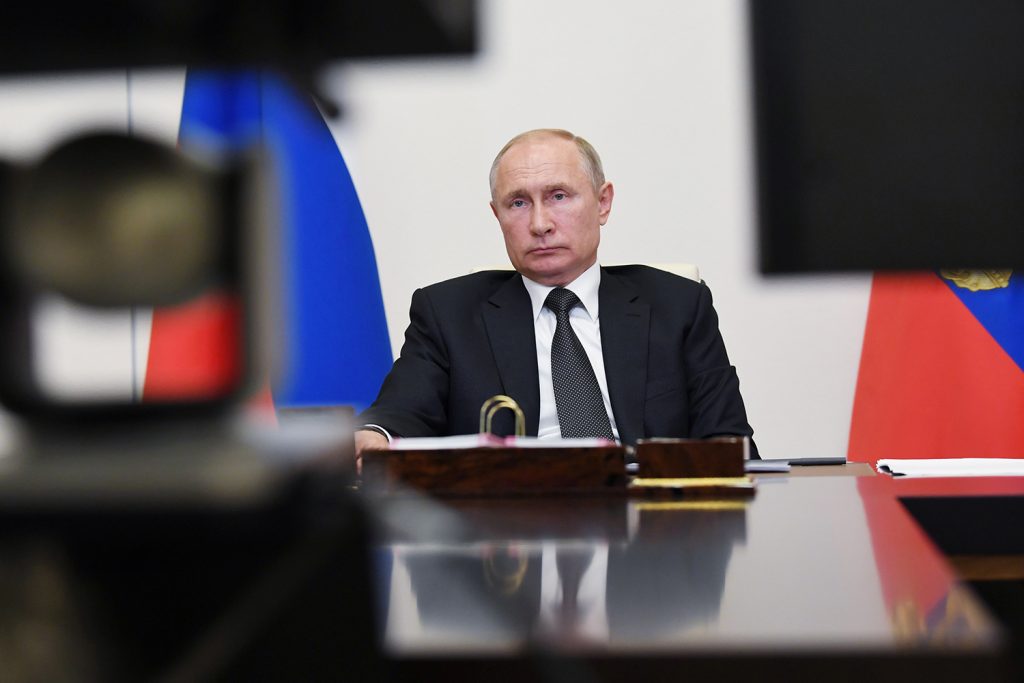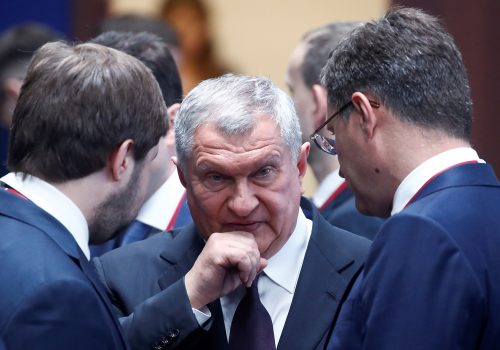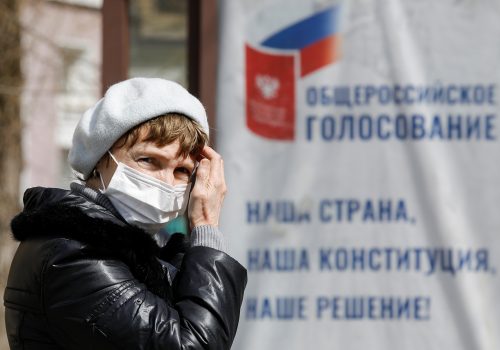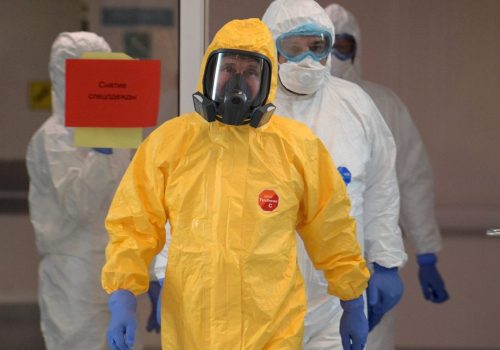Under President Vladimir Putin, the Russian economy has gone through two distinct periods. From 1999-2008, Russia boomed with an average growth of 7 percent a year. Since 2009, Russia’s economy has stagnated with an average annual growth of 1 percent. The coronavirus and the oil price war have brought Russia into a new economic crisis. How deep will it become and how will the Russian economy recover?
When Putin was appointed president in 2000, he arrived at a laid table. He benefited from Boris Yeltsin’s market reforms in the 1990s and the Russian financial crash in 1998, which forced Russia to become fiscally responsible, cleaning out incompetent accidental enterprise owners through mass bankruptcy. During his first term, Putin continued Yeltsin’s reforms, even improving the economic and legal system.
From 2003, global oil prices rose, allowing Putin to abandon reforms. While benefiting from a global commodity boom, he promoted state and crony capitalism. The tipping point was the arrest of Mikhail Khodorkovsky, the main owner of the Yukos Oil Company, in October 2003 and the ensuing confiscation of Yukos. Yet, Putin maintained his focus on rebuilding the public finances. Russia had steady budget and current account surpluses allowing it to minimize its public debt and accumulate large international currency reserves.
The global financial crisis in 2008 came as a rude shock to Putin. High and rising oil prices had bred the concept of Russia as an energy superpower, but in 2008 oil prices plunged temporarily by 80 percent, and the Russian stock exchange plummeted in parallel. Flush with large currency reserves from oil money, Putin undertook a major bailout of the big state and oligarchic companies, which crowded out smaller private companies. A decade of near stagnation followed, though macroeconomic stability was stellar.
Since Putin could no longer satisfy the Russian people with high economic growth and rising standard of living, he opted for small victorious wars instead, first in Georgia in August 2008 and then the annexation of Crimea in March 2014. But his war on Ukraine provoked substantial Western sanctions, notably financial sanctions from July 2014, which depressed Russian economic growth by 1-1.5 percentage points each year, but also severe personal sanctions against his closest collaborators. Since Russia is continuing its daily shooting war, having made no concessions on Ukraine, the Western sanctions hold and have gradually tightened.
Subscribe for the latest on Russia
Receive updates for events, news, and publications on Russia from the Atlantic Council.
In 2012, Putin returned to the presidency, demoting Dmitri Medvedev to prime minister. He formed a new government with substantial personnel changes and adopted a government program of eleven broad but vague decrees, which contained no reforms. Since the weak and hapless Dmitri Medvedev was prime minister, the government played little role. Putin himself made major economic policy decisions together with key ministers, in what Russians called “manual management.”
Since 2014, the Russian economy has been characterized by stagnation. Real disposable incomes fell by 13 percent from 2014-18, according to Russia’s official statistics. As a consequence of the Western financial sanctions, Russia’s total foreign indebtedness declined from $732 billion in June 2014 to $455 billion in December 2018, which restricted Russia’s investment and consumption and thus economic growth. Putin has proven remarkably disinterested in economic growth or reforms that could boost growth, while he is all the more focused on macroeconomic stability. This stability was supported by a transition to a floating exchange rate from December 2014, which means that the Russian exchange rate floats with the price of oil. Russia has also kept its budget close to balanced. Its public debt stayed at 13 percent of gross domestic product (GDP), and Russia gradually built up its international currency reserves to $560 billion in March 2020.
In 2018, Putin started his fourth term as president with even less economic ambitions than in 2012. After a long time with a stable government, he made substantial changes, though Medvedev remained prime minister. He issued one single programmatic decree, which was exceedingly vague, clarifying that reforms were out of question. It focused on thirteen national projects, mainly infrastructure. The apparent idea was to boost economic growth through more public investment, but investment stayed low and foreign investors were scared away by stagnation, increased nationalism, and Western sanctions. In 2018 and 2019, however, the government failed to get the money out of the door, and Russia recorded larger budget surpluses than planned in both years, while the growth rate in 2019 stayed at a miserably low 1.3 percent.
Then 2020 arrived with hard blows. On January 15, Putin held his annual state of Russia speech to the Federal Assembly. His main two themes were demography and constitutional change. A third theme was the Victory Day March on May 9. He praised the macroeconomic stability as usual but called for an increase in the investment ratio from 21 percent of GDP to 25 percent of GDP in 2025.
Unexpectedly, Putin made a major government change, replacing Medvedev as prime minister with Mikhail Mishustin, the head of the tax service and a forceful technocrat. His mandate was to spend more government money on Putin’s thirteen national projects.
Personally, Putin was preoccupied with two other pet projects, a constitutional plebiscite set for April 22 and the Victory Day Parade on the 75th anniversary of the end of World War II. His focus on these two events appears to have dimmed his perception of the coronavirus crisis and made him reluctant to do anything that would delay either event, which he eventually had to postpone until an unknown time in the future. For a long time, he played it down and treated COVID-19 as a problem in China, South Korea, and Italy. Russia even sent medical assistance to Italy, Serbia, and the United States, while Russian authorities were suppressing information about the rising domestic epidemic.
Enter COVID
The first Russian COVID-19 cases were registered on February 15 and the first death on March 19. Only on March 25, thirty-nine days after the first case, officials started to implement anti-crisis measures. Gradually Putin became more concerned, devoting several addresses to the nation on this theme. Putin chose to offer holidays and social benefits in his speeches, while he instructed underlings to impose restrictive measures, which rendered the official message unclear and incoherent.
On March 25, Putin promised the population one week of paid holidays and a number of social benefits, while postponing the constitutional plebiscite. Muscovites thought that Putin meant a real holiday and millions left the city, which had become the main center of infection. On April 2, Putin added paid holidays for all until the end of April. On April 16, Putin told the people that the Victory March on May 9 had been postponed. Finally, on April 28 Putin announced that the paid holidays would last until May 11 and added some social benefits. But Putin’s repeated promises about paid leave for everybody were not true. A Levada Center poll showed that 44 percent worked as usual, 21 percent worked from home, and 15 percent had lost their jobs. Only 8 percent were actually on leave with full salaries.
Putin delegated restrictive measures to the government, but Prime Minister Mishustin did nothing. Instead, Putin passed on the task to the regional governors, who are appointed and used to just obeying orders from the Kremlin. Suddenly, they were supposed to take their own initiatives. Moscow Mayor Sergei Sobyanin became the actual crisis manager. Russia’s first restrictive measure was to close the borders for foreigners, which came naturally given Russia’s strict visa regulations.
Only on March 29, Mayor Sobyanin suddenly imposed strict quarantine on Moscow City. Other governors followed, and the next week Russia’s parliament adopted a relatively strict quarantine law. On April 30, Mishustin declared that he had been infected, and Putin appointed his first deputy as acting prime minister. The assumption was that Mishustin would not return. Although COVID-19 hit Russia late, the country has seen a late exponential rise in infections and its still low death rate is set to rise sharply. While its quarantine policies have been late and incoherent, they have become quite strict. Political scientist Lilia Shevtsova commented, “The regions started to close their borders, which undermined the state’s cohesion. The federal and regional authorities have been issuing contradictory orders. The state machine appears totally disoriented.”
Energy and Economic crises
Barely two weeks after global financial markets had started running wild because of the COVID-19 pandemic, Russia launched an oil price war with Saudi Arabia on March 6, which became an additional distraction. Oil prices collapsed, which greatly aggravated Russia’s financial crisis. The lower oil price will cause a significant GDP decline on top of the coronavirus fall. The Brent oil price has fallen from $60 per barrel at the beginning of 2020 to around $25 per barrel at present.
On March 25 and April 15, respectively, Russia adopted two economic anti-crisis packages. They included fiscal benefits, social benefits, increased unemployment benefits, credit subsidies for people, tax concessions for small and medium-sized enterprises, and corporate subsidies. Together these two packages were modest at only 2.6 percent of GDP, much less than the anti-crisis program of 2008-9. In early May, the ministry of finance still planned for a budget deficit of only 4 percent of GDP. On May 11, Putin made a fifth national address on the coronavirus crisis and offered a third anti-crisis package with more social benefits.
Statements have been made that Russia would spend $300 million a day out of its sovereign wealth fund of $165 billion, but actual amounts being spent appear less. Putin has recognized that the non-arrival of promised benefits is common. The whole Russian financial regime is organized to contain public spending, but the fundamental reason is that Putin is focused on maintaining strong public and international finances to safeguard his sovereignty, while the demands from the population are less important to him. Russia’s finances are likely to stay strong, while the Russian people will suffer.
Remaining liberal economists demanded a more substantial fiscal stimulus of 6-10 percent of GDP and that it be more focused on the population and small firms. The Central Bank of Russia has cut its interest rate from 6 percent per annum to 5.5 percent per annum and further rate cuts are expected and provided multiple kinds of liquidity support. Putin’s obvious preference is strong public finances.
Russia will see a big fall in output in 2020, presumably about as much as in the European Union. The expected growth without crisis would have been a mediocre 1 percent. Much of the service sector, perhaps one quarter of GDP (slightly less than in the EU) is likely to be closed for about three months because of the quarantine, which will mean a reduction in GDP of 6 percent. In addition, the oil price appears to be staying around $25 per barrel in 2020 rather than $64 per barrel in 2019, and the Central Bank of Russia has assessed that such a low oil price would lead to a reduction of Russia’s GDP of 4 percent. Thanks to its strong finances, Russia is not likely to suffer significantly from the global financial crisis. Adding up these factors, Russia’s GDP would be expected to decline by 9 percent, approximately as much as is anticipated in the European Union.
Russia’s response to the COVID-19 epidemic and the ensuing economic crisis does not impress. Arguably, it has hardly been worse than the average EU response—except for the Central European countries, where the pandemic arrived late and who protected themselves much better. The Russian authorities’ attempts to deny and conceal the epidemic have undermined popular trust in Putin, which is lower than ever. Nor have the authorities shown any sign of restart long dormant reforms.
As a consequence of the declining GDP and a lower exchange rate, Russia’s GDP in current dollars, which peaked at $2.3 trillion in 2013, is now set to decline from $1.64 trillion in 2019 to approximately $1.3 trillion in 2020, assuming a GDP decline of 9 percent and an average exchange rate of 75 rubles per US dollar. This will reduce Russia’s might on the international stage.
Anders Åslund is a senior fellow at the Eurasian Center at the Atlantic Council.
The Atlantic Council developed this report with the support of the Future of Russia Foundation (UK Charity), a project developed and supported by Mikhail Khodorkovsky.
Further reading:

The Eurasia Center’s mission is to promote policies that strengthen stability, democratic values, and prosperity in Eurasia, from Eastern Europe in the West to the Caucasus, Russia, and Central Asia in the East.
Image: Russian President Vladimir Putin takes part in a video conference call with officials and public representatives of the region of Dagestan amid the coronavirus disease (COVID-19) outbreak at the Novo-Ogaryovo state residence outside Moscow, Russia May 18, 2020. Sputnik/Alexei Nikolskyi/Kremlin via REUTERS



